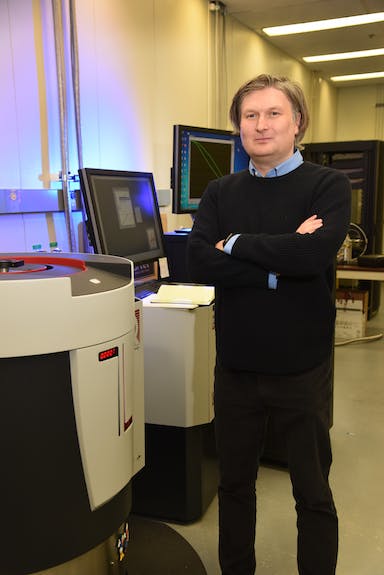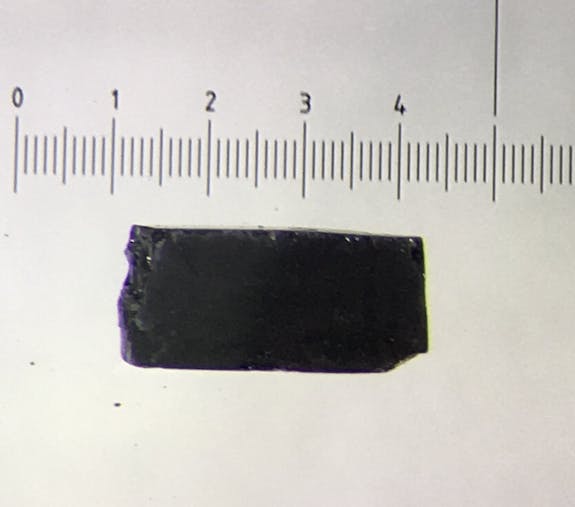Researchers spend a lot of time studying uranium dioxide, or UO2, for a good reason. It’s the fuel that powers 95 percent of the world’s nuclear reactors. Even so, UO2 can still produce some surprises, such as a 2017 discovery that when squeezed it becomes piezomagnetic. Piezomagnetism happens because the material is essentially full of tiny magnets, with the result being a three-dimensional magnetic structure. A simple magnet has a north and south pole, and so its magnetism points in a single direction from one pole to the other. UO2, in contrast, has magnetism that points in three different directions at the same time, a complex structure that was suspected before but is now confirmed by a group led by Idaho National Laboratory (INL) researchers.
“If we could understand what is the mechanism behind the piezomagnetic effect, then we can actually use it to our advantage,” said Krzysztof Gofryk, a physicist who leads a group studying radioactive elements at INL and participated in this study.

Gofryk was part of a team from INL, Argonne National Laboratory, Los Alamos National Laboratory, and several universities that looked at this effect on a small scale, reporting on their work in Nature Communications Materials. Examining single crystal samples of UO2, they found that piezomagnetism arises because of the microscopic structure of material, how the “tiny magnets” are arranged inside the crystal, and how the atoms interact with each other.
Knowing such fundamental material properties might make it possible to alter the UO2 fuel slightly, thereby increasing its heat transportation and boosting the efficiency of nuclear reactors. “Even improving efficiency by a few percent could lead to several hundred million of dollars of savings for the nuclear industry,” Gofryk said.
He added that this work was only possible because of the use of specialized facilities and scientific expertise. Scientists from INL led, designed, supervised, and executed the project. Those from Los Alamos National Laboratory supplied a high-quality single crystal UO2 sample. For this work, the researchers used Argonne National Laboratory’s Advanced Photon Source, which produces a large flood of X-rays. The facility can also subject samples to a magnetic field while sending X-rays through them.
The researchers used this photon source to examine UO2 crystals on a molecular scale while subjecting them to short 20 millisecond bursts of magnetic fields as high as 20-30 Tesla- that’s as much as 6000 times as intense as the average refrigerator magnet.
The deluge of X-rays and the relatively weak signal from the sample meant that the experiment needed a detector capable of working with a very bright source and a very dim signal. Cornell University supplied the special detector needed in another example of the coming together of equipment and expertise, according to Gofryk.
When cooled below negative 405 degrees Fahrenheit, the UO2 became piezomagnetic, and it would minutely expand or contract in response to the external magnetic field the researchers applied. With the X-ray source, the scientists could see this otherwise undetectable movement.
As for possible applications of the research, he noted that one goal of the study of such fundamental properties is to improve the performance of nuclear fuels in reactors. A critical factor in such performance is understanding how the fuel conducts the heat generated by nuclear processes. Because the fuel’s magnetism is related to its structure and atomic interactions, it provides clues about how UO2 responds to strain, heat, magnetic fields, and other environmental factors.
The information from these experiments can then be used in models to simulate what happens to the fuel in a reactor. To make the modeling and simulation as accurate as possible, scientists need to know as much as they can about the material’s basic properties. The research on this important nuclear fuel done by the team of scientists helps fill in some important gaps and will pay dividends, Gofryk said.

“The progress we are making in understanding the magnetic properties of UO2 will help in future modeling and simulation of this material,” he predicted.
He added that fundamental material research into UO2 continues, with experiments planned, for instance, to better capture exactly what happens when the fuel is subjected to a high and steady magnetic field. Part of this work may be done at INL, which has a new and powerful magnet available.
This continuing research is part of a back-and-forth between experiments and modeling/simulation. It’s also necessary because what was thought to be a well-understood and surprise-free material may actually not be.
“Many people assumed this material was very well known,” Gofryk said of UO2. “But it looks like there are a lot of surprises still in there.”
Gofryk’s research was supported by the U.S. Department of Energy, Early Career Research Program under the project “Actinide materials under extreme conditions.”
Learn more about INL’s nuclear energy research capabilities here.





